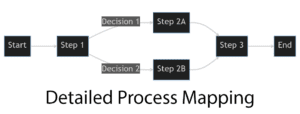What is Poka-Yoke?
Poka-Yoke, a Japanese term meaning “mistake-proofing,” is a method used to prevent or detect human errors before they transform into defects. It’s not about identifying a mistake after it has occurred, but rather about creating a process where the error cannot happen in the first place. This unique approach makes it an essential tool in the Six Sigma practitioner’s arsenal.
Why is Poka-Yoke Relevant in Six Sigma?
Six Sigma methodology, known for its rigorous focus on quality and continuous improvement, leverages various tools and techniques to minimize errors and reduce variability in processes. Poka-Yoke fits perfectly within this framework, serving as a practical solution to eliminate mistakes at their source.
Imagine you’re assembling a product, and one component has to be fitted in a specific way. If it’s done incorrectly, it will cause a defect later in the process. By designing a fixture that only allows the component to fit in the correct orientation, you’ve implemented a simple yet effective Poka-Yoke.
Capturing Interest Across Levels
Whether you are new to Six Sigma or an experienced practitioner, the concept of Poka-Yoke holds substantial value. For beginners, it’s a gateway to understanding how systematic error prevention can lead to remarkable quality improvements. For seasoned professionals, it offers innovative ways to enhance existing processes, aligning with the core Six Sigma principle of striving for perfection.
By embracing Poka-Yoke, organizations can not only prevent errors but also foster a culture where quality is at the forefront. As we delve into this article, we’ll explore various applications of Poka-Yoke in Six Sigma, showcase practical examples across different industries, and equip you with the best practices to apply this essential tool. If you’re intrigued by the notion of mistake-proofing, stay with us as we unpack the world of Poka-Yoke.
In This Guide
Applications of Poka-Yoke in Six Sigma
The robust methodology of Six Sigma thrives on precision, consistency, and continuous improvement. Within this landscape, Poka-Yoke stands out as a versatile tool, seamlessly integrating with various aspects of Six Sigma. Below, we explore the multifaceted applications of Poka-Yoke.
Error Prevention and Detection
- Preventing Mistakes at the Source: Instead of correcting errors after they occur, Poka-Yoke emphasizes designing processes so that mistakes are impossible or immediately noticeable.
- Complementing Six Sigma’s DMAIC: During the Improve phase of Six Sigma’s DMAIC (Define, Measure, Analyze, Improve, Control) cycle, Poka-Yoke techniques can be employed to rectify root causes of errors.
Standardization and Consistency
- Enforcing Standard Operating Procedures: Poka-Yoke aids in maintaining uniformity across processes by enforcing SOPs, making it easier to maintain the desired level of quality.
- Eliminating Variability: By ensuring that every part or process meets specific standards, Poka-Yoke assists in reducing variability, a core goal of Six Sigma.
Integration with Other Six Sigma Tools
- Synergy with Lean Principles: Poka-Yoke often works hand-in-hand with Lean methodologies, aiding in waste reduction and efficiency improvement.
- Collaboration with Control Charts and SPC: Statistical Process Control (SPC) and control charts can be enhanced by implementing Poka-Yoke to maintain process control.
Poka-Yoke’s applications in Six Sigma are as diverse as they are impactful. By aligning with Six Sigma’s ethos of quality and efficiency, Poka-Yoke serves as an essential tool in preventing errors, ensuring consistency, and enhancing collaboration with other methodologies. Whether it’s designing a process that’s immune to mistakes or enforcing stringent standards, Poka-Yoke offers invaluable solutions that resonate with Six Sigma’s pursuit of excellence.
Subscribe to our newsletter!
Practical Examples of Poka-Yoke in Six Sigma
Poka-Yoke’s adaptability extends across various sectors, where its principles of mistake-proofing have led to remarkable improvements. Below, we highlight real-world examples of how this tool has been successfully applied.
Manufacturing: Assembly Line Error Reduction
- Problem: Incorrectly assembled components causing defects.
- Poka-Yoke Solution: Designing jigs that allow components to fit in one specific orientation.
- Outcome: Reduced defects and increased production efficiency.
Healthcare: Medication Dispensing Accuracy
- Problem: Errors in dispensing the correct dosage of medication.
- Poka-Yoke Solution: Implementing color-coded or shape-coded containers for different medications.
- Outcome: Elimination of dosage errors, enhancing patient safety.
Information Technology: Data Entry Accuracy
- Problem: Frequent mistakes in data entry leading to information inconsistencies.
- Poka-Yoke Solution: Utilizing drop-down menus and validation rules to guide correct data input.
- Outcome: Improved data integrity and reduced time spent on corrections.
Retail: Checkout Process Efficiency
- Problem: Delays and errors in the checkout process.
- Poka-Yoke Solution: Integrating barcode scanning and automatic pricing, along with alerts for special handling instructions.
- Outcome: Faster checkout times and reduced human errors.
Table: Summary of Practical Examples
| Industry | Problem | Poka-Yoke Solution | Outcome |
| Manufacturing | Incorrect assembly | Component-specific jigs | Reduced defects |
| Healthcare | Dosage errors | Color/shape-coded containers | Enhanced patient safety |
| Information Tech | Data entry mistakes | Drop-down menus and validation rules | Improved data integrity |
| Retail | Checkout delays | Barcode scanning and automatic pricing | Faster checkout times |
From production lines to patient care, Poka-Yoke’s applications transcend industry boundaries, reinforcing its status as a versatile and practical tool within Six Sigma. These real-world examples illuminate how simple, yet ingenious, mistake-proofing mechanisms can significantly enhance quality and efficiency across diverse domains.
FAQ: Understanding Poka-Yoke in Six Sigma
As Poka-Yoke continues to be an essential part of Six Sigma methodologies, several common questions arise among both beginners and seasoned professionals. Below, we address some of these frequent queries.
1. What Does Poka-Yoke Mean, and Where Did It Originate?
- Answer: Poka-Yoke translates to “mistake-proofing” in Japanese. It was developed by Shigeo Shingo, a Japanese engineer, as a part of the Toyota Production System. The main idea is to design processes in a way that prevents errors from occurring or makes them immediately detectable.
2. How Does Poka-Yoke Differ from Traditional Quality Control?
- Answer: Traditional quality control often involves detecting errors after they occur, whereas Poka-Yoke emphasizes preventing errors at the source. It’s a proactive approach that aims to design processes where mistakes are impossible or quickly identified.
3. Can Poka-Yoke Be Applied Outside Manufacturing?
- Answer: Absolutely! While Poka-Yoke started in manufacturing, its principles of error prevention are widely applicable across industries like healthcare, IT, retail, and more.
4. How Complex Are Poka-Yoke Solutions?
- Answer: Poka-Yoke solutions are often simple and inexpensive. The goal is to find clever ways to prevent errors using readily available tools and design features.
5. How Does Poka-Yoke Align with Six Sigma Principles?
- Answer: Poka-Yoke aligns with Six Sigma by aiding in error reduction and process consistency, which are core principles of Six Sigma. It supports the Improve and Control phases of the DMAIC cycle and complements other Six Sigma tools.
Understanding Poka-Yoke’s philosophy, application, and alignment with Six Sigma offers invaluable insights for those looking to enhance quality and efficiency in their processes. By embracing the simplicity and universality of Poka-Yoke, organizations can create a robust framework that resonates with Six Sigma’s pursuit of perfection.
Best Practices and Tips for Implementing Poka-Yoke
Implementing Poka-Yoke successfully demands a strategic approach that aligns with the unique requirements of your process. Here are some best practices and tips to ensure the effective application of Poka-Yoke within Six Sigma:

Understand the Process Thoroughly
- Analyze existing processes to identify potential error points.
- Engage with team members who interact with the process regularly for insights.
Choose the Right Type of Poka-Yoke
- Decide between error prevention (making mistakes impossible) and error detection (identifying mistakes as they occur).
- Tailor the solution to the specific problem at hand.
Keep It Simple and Cost-Effective
- Focus on simple, easily implemented solutions that don’t require significant investment.
- Leverage existing tools or minor modifications to existing processes.
Test and Refine Your Solutions
- Implement the Poka-Yoke solution on a small scale first to test its effectiveness.
- Continuously monitor and refine the solution as needed.
Educate and Involve Your Team
- Ensure that all team members understand the purpose and function of the Poka-Yoke solution.
- Encourage feedback and collaboration to ensure ongoing success.
Align with Six Sigma Principles
- Ensure that the Poka-Yoke implementation is in harmony with Six Sigma’s focus on quality, consistency, and continuous improvement.
- Utilize Poka-Yoke during the Improve and Control phases of the DMAIC cycle.
Implementing Poka-Yoke is not just about selecting the right tool but about embracing a philosophy of continuous improvement and error prevention. By adhering to these best practices and aligning with Six Sigma’s principles, organizations can cultivate a culture where quality is not an afterthought but a foundational element. Whether you are starting your Six Sigma journey or looking to refine existing processes, these guidelines provide a structured pathway to unlock the true potential of Poka-Yoke.
Conclusion: Embracing Poka-Yoke in Your Six Sigma Journey
Poka-Yoke’s power lies in its simplicity, adaptability, and alignment with Six Sigma’s relentless pursuit of quality and efficiency. From its origins in manufacturing to its wide-reaching applications across diverse industries, Poka-Yoke has proven to be an indispensable tool for error prevention and detection.
Key Takeaways:
- Understanding Poka-Yoke: Embrace its philosophy of mistake-proofing, whether through error prevention or immediate detection.
- Versatility in Application: Appreciate its broad applicability, transcending traditional industry boundaries.
- Practical Insights: Leverage real-world examples to inspire your own Poka-Yoke solutions.
- Strategic Implementation: Follow the outlined best practices and tips for a successful implementation within your Six Sigma framework.
As you continue to explore the endless possibilities of Six Sigma, let Poka-Yoke guide you in creating robust, error-free processes. Whether you are a beginner just starting your journey or a seasoned practitioner looking to refine your skills, Poka-Yoke offers a timeless methodology that resonates with Six Sigma’s core values.
Image Suggestion: Consider an inspiring image that encapsulates the journey of continuous improvement. Visual elements that represent growth, learning, and quality could provide a compelling conclusion to the article.
Join Our Newsletter!: Looking to stay updated on the latest Six Sigma tools, guides, and resources? Sign up for our newsletter to receive exclusive content, tailored to support your Six Sigma journey. Whether it’s in-depth articles, practical tools, or engaging webinars, our newsletter brings the world of Six Sigma directly to your inbox.
Subscribe to our newsletter!
Thank you for engaging with this exploration of Poka-Yoke in Six Sigma. We hope that this article has not only provided you with a clear understanding but has also inspired you to explore and apply this invaluable tool in your practices. Together, let’s continue to make the complex simple, the inaccessible accessible, and the theoretical practical.
Feel free to reach out with feedback, questions, or insights, and remember, the journey towards perfection is a path filled with continuous learning and growth. Happy mistake-proofing!







